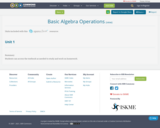
Students can access the textbook as needed to study and work on homework.
- Subject:
- Algebra
- Mathematics
- Material Type:
- Textbook
- Date Added:
- 09/25/2019

Students can access the textbook as needed to study and work on homework.

Chapter 1. Concepts
Chapter 2. Linear Equations
Chapter 3. Graphing
Chapter 4. Linear Systems
Chapter 5. Polynomial Equations
Chapter 6. Factoring Polynomials
Chapter 7. Rational Expressions
Chapter 8. Radicals
Chapter 9. Quadratic Equations
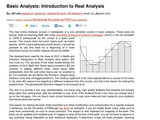
This free online textbook is a one semester course in basic analysis. These were my lecture notes for teaching Math 444 at the University of Illinois at Urbana-Champaign (UIUC) in fall 2009. The course is a first course in mathematical analysis aimed at students who do not necessarily wish to continue a graduate study in mathematics. A Sample Darboux sums prerequisite for the course is a basic proof course. The course does not cover topics such as metric spaces, which a more advanced course would. It should be possible to use these notes for a beginning of a more advanced course, but further material should be added.

This workbook was created through the efforts of three instructors at Scottsdale Community College in Scottsdale, Arizona. Any individual may download and utilize a digital copy of this workbook for free. The Creative Commons licensing of this text allows others to freely use, modify, or remix any of the information presented here. Contact Donna Gaudet at dgaudet.scc@gmail.com if you are an instructor that wishes to teach with these materials or adapt and edit them for teaching. 238 pages.
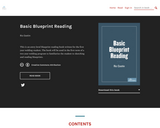
Short Description:
This is an entry level blueprint reading book written for the first year welding student. The book will be used in the first term of a two year welding program to familiarize the student to sketching and reading blueprints.
Word Count: 7979
ISBN: 978-1-63635-031-8
(Note: This resource's metadata has been created automatically by reformatting and/or combining the information that the author initially provided as part of a bulk import process.)

A grasp of the logic and practice of science is essential to understand the rest of the world around us. To that end, the CMB4e iText (like earlier editions) remains focused on experimental support for what we know about cell and molecular biology, and on showing students the relationship of cell structure and function. Rather than trying to be a comprehensive reference book, CMB4e selectively details investigative questions, methods and experiments that lead to our understanding of cell biology. This focus is nowhere more obvious than in the chapter learning objectives and in external links to supplementary material. The Basic CMB3e version of the iText includes links to external web-sources as well as the author’s short, just-in-time YouTube VOPs (with edited, optional closed captions), all embedded in or near relevant text. Each video is identified with a descriptive title and video play and QR bar codes.
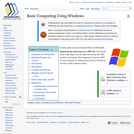
A computer is an automatic, electronic, data-processing machine that takes in facts and figures known as data, and then processes or organizes it in some useful way. Afterwards it outputs, or displays, the results for you to see as information. Keep in mind that data is not information. Rather, information is the knowledge that you, the end-user, derive from accurate data that are entered into a computer. Only after processing, is data transformed into information which is then used for decision making. (Almost) each part of a computer can be classified as either hardware or software.
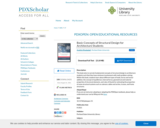
This book aims to narrate fundamental concepts of structural design to architecture students such that they have minimum involvement with math problem-solving. Within this book, students learn about different types of loads, forces and vector addition, the concept of equilibrium, internal forces, geometrical and material properties of structural elements, and rules of thumb for estimating the proportion of some structural systems such as catenary cables and arches, trusses, and frame structures.

Short Description:
This book aims to narrate fundamental concepts of structural design to architecture students such that they have minimum involvement with math problem-solving. Within this book, students learn about different types of loads, forces and vector addition, the concept of equilibrium, internal forces, geometrical and material properties of structural elements, and rules of thumb for estimating the proportion of some structural systems such as catenary cables and arches, trusses, and frame structures.
Long Description:
This book aims to narrate fundamental concepts of structural design to architecture students such that they have minimum involvement with math problem-solving. Within this book, students learn about different types of loads, forces and vector addition, the concept of equilibrium, internal forces, geometrical and material properties of structural elements, and rules of thumb for estimating the proportion of some structural systems such as catenary cables and arches, trusses, and frame structures.
Word Count: 12850
(Note: This resource's metadata has been created automatically by reformatting and/or combining the information that the author initially provided as part of a bulk import process.)

To safely work with electricity, it is important to have a grasp of the basic theories. Whether we are talking about atomic structure, electrical terms, or measurement devices, understanding the theory of electricity is a key concept. This textbook, divided into three sections, provides easy-to-understand and enjoyable lessons on atomic structure, electrical units, and measurement devices for those training and working as electricians.

Word Count: 16252
(Note: This resource's metadata has been created automatically by reformatting and/or combining the information that the author initially provided as part of a bulk import process.)

Video and study guides for the following topics: Order of operations, algebraic manipulation, negative and fractional exponents, rounding, engineering notation, unit conversion, general industrial safety, energy, power, efficiency, capacity factor, basic electrical properties: voltage, current, resistance, fixed resistors, variable resistors, protoboards, ohmmeters, series resistors, parallel resistors, 4 band resistor color code, DC Ohm’s Law, DC power, voltmeters, ammeters, series DC circuit properties, DC Kirchhoff’s Voltage Law, DC voltage divider rule, parallel DC circuit properties, DC Kirchhoff’s Current Law, DC current divider rule, series-parallel DC circuit properties, instrument loading effects, DC current sources, source conversion, resistive delta-Y conversion, complex DC circuits, DC Superposition Theorem, DC Thevenin’s Theorem, DC Maximum Power Transfer Theorem, DC Norton’s Theorem
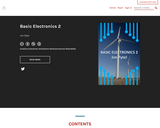
This course is the 2nd in a three part series intended to support the flipped classroom approach for traditional basic electronics classes. Basic Electronics 2 covers capacitors and the transient capacitor charge and discharge process, inductors and the transient inductor storage and release process, sinusoidal properties, complex numbers and complex impedance, phasors, AC Ohm’s Law, series AC circuit analysis, parallel AC circuit analysis, and series-parallel AC circuit analysis. The text includes discussions of Kirchhoff’s Voltage Law, the AC Voltage Divider Rule, Kirchhoff’s Current Law, and the AC Current Divider Rule. Additionally the text covers use of AC voltmeters, AC ammeters, function generators, and oscilloscopes. These resources are meant to accompany a hands on lab with the guidance of an instructor.
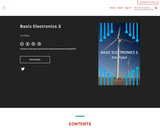
This course is the 3rd installment in a three part series intended to support the flipped classroom approach for traditional basic electronics classes. Basic Electronics 3 covers apparent, real, and reactive power and power factor, power factor correction, ideal and non-ideal transformers, and transformer connection diagrams, AC circuit analysis techniques and theorems like source conversion, the AC superposition theorem, AC Thevenin’s Theorem, and the AC Maximum Power Transfer Theorem, 3 phase AC systems including balanced and unbalanced 4 wire Y configurations, 3 wire Y configurations, and delta configurations, the single wattmeter method and the two wattmeter method. These resources are meant to accompany a hands on lab with the guidance of an instructor.

This open book by Catherine Schmidt-Jones has units on time elements (rhythm and meter), pitch elements (timbre, melody, and harmony), and the combination of these elements. The textbook is being provided in both PDF and html formats for download.
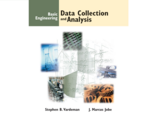
In Basic Engineering Data Collection and Analysis, Stephen B. Vardeman and J. Marcus Jobe stress the practical over the theoretical. Step by step, students get real engineering data and scenario examples along with chapter-long case studies that illustrate concepts in realistic, thoroughly detailed situations. This approach encourages students to work through the material by carrying out data collection and analysis projects from problem formulation through the preparation of professional technical reports—just as if they were on the job.
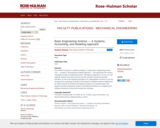
This textbook is based on a different paradigm for organizing an engineering science core --- a systems, accounting and modeling approach --- that emphasizes the common, underlying concepts of engineering science. Although this approach is not new, as most graduate students have been struck by this idea sometime during their graduate education, its use as the organizing principle for an undergraduate curriculum is new. By focusing on the underlying concepts and stressing the similarities between subjects that are often perceived by students (and taught by faculty) as unconnected topics, this approach provides engineering students a foundational framework for recognizing and building connections as they travel through their education.

After completing this unit, the student will be able to discuss the historical perspective of foot care, identify the role of the Registered Nurse and Registered Practical Nurse in foot care, recognize the limitations beyond the scope of practice of foot care for Registered Nurses and Registered Practical Nurses and make appropriate referral, and identify other providers of foot care and their scope of practice.
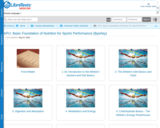
Physical activity and/or exercise confers many benefits. It improves our mental outlook and capacity, our self-image and self-confidence, and provides independence for the elderly. Moving can also increase lean body mass and decrease body fat, increases bone mass, and improve heart, lung, and muscle function. Morbidity and mortality are lower in people who are physically active compared to people who are sedentary. Also, the risk is reduced for cardiovascular disease, hypertension, stroke, type II diabetes, cancer, particularly colon and breast, osteoporosis, and gallbladder disease.
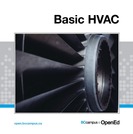
This readily accessible online introductory resource was developed for anyone who has interest in, or works with, HVAC controls and equipment. Designed for electrical and HVAC apprentices learning about the subject in school, you will find the descriptive text and original diagrams easy to navigate through, while the question bank will help students review the subject matter covered in each section.